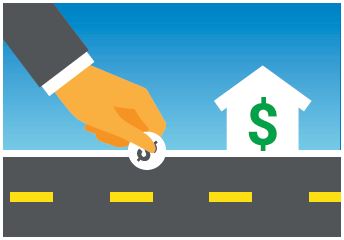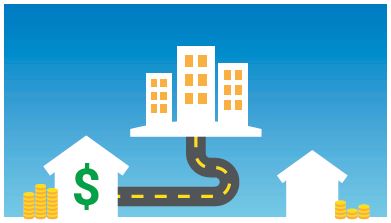Value capture presents an opportunity to meet funding challenges for transportation projects at a local and State level.
Value capture refers to a set of techniques that take advantage of increases in property values, economic activity, and growth linked to infrastructure investments to help fund current or future improvements.

Value capture returns a portion of land value created by transportation to be used for future investments.

A new or improved highway that connects to economic activity will benefit adjacent parcels. Similar parcels without those connections do not increase in value.
The following techniques demonstrate powerful tools that can address funding gaps.
Developer Contributions include Impact Fees and Negotiated Exactions. They are one-time charges collected by local governments from developers to offset the cost of infrastructure and services necessitated by new development.
Special Assessments include Special Assessment Districts, Business Improvement Districts, Sales Tax Districts, and Land Value Taxes. These are additional fees or taxes assessed on businesses or residents in specified geographic areas benefiting proximity to a highway or other transportation facility or corridor.
Fees include Transportation Utility Fees which are similar to a utility fee and are assessed based on how individual businesses and households use transportation facilities.
Incremental Growth includes Tax Incremental Finance, Transportation Reinvestment Zones, and Tax Allocation Districts. These mechanisms allocate back to infrastructure from some specified portion of increased property tax revenues fostered by new infrastructure - often for a specified period of time.
Joint Development includes At Grade, Below Grade, and Above Grade (or Air Rights). This is the sale or lease of land or air rights on or adjacent to transportation facilities. This can include donations of land or other in-kind resources from the private sector in ongoing commercial operations.
Concessions include Asset Recycling. This is the sale or lease of government-owned assets - such as toll roads or bridges - to private-sector investors/operators.
Advertising and Naming Rights are the sale of advertising space or naming rights on a transportation facility. Note: Commercial uses within Interstate Highway System right of way, including rest areas, is prohibited by law; however, they may be allowed on toll facilities and in transit stations.
States such as California, Colorado, Florida, Georgia, Massachusetts, Missouri, Ohio, Oregon, Pennsylvania, Texas, and Virginia, as well as the District of Columbia, are using value capture options successfully. The following are examples of different value capture applications supporting highway improvements across the United States:
FHWA EDC-5 Value Capture: Capitalizing on the Value Created by Transportation https://www.fhwa.dot.gov/innovation/everydaycounts/edc_5/value_capture.cfm
FHWA Center for Innovative Finance Support – Value Capture https://www.fhwa.dot.gov/ipd/value_capture